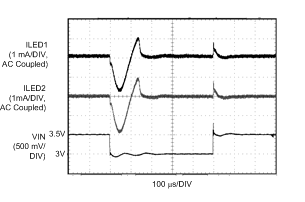SNOSC68C April 2012 – September 2015 LM3533
PRODUCTION DATA.
- 1 Features
- 2 Applications
- 3 Description
- 4 Revision History
- 5 Pin Configuration and Functions
- 6 Specifications
-
7 Detailed Description
- 7.1 Overview
- 7.2 Functional Block Diagram
- 7.3 Feature Description
- 7.4
Device Functional Modes
- 7.4.1 High-Voltage Boost Converter
- 7.4.2 Integrated Charge Pump
- 7.4.3 LED Current Mapping Modes
- 7.4.4 LED Current Ramping
- 7.4.5 Brightness Register Current Control
- 7.4.6 PWM Control
- 7.4.7 ALS Current Control
- 7.4.8
ALS Functional Blocks
- 7.4.8.1 ALS Input
- 7.4.8.2 Analog Output Ambient Light Sensors (ALS Gain Setting Resistors)
- 7.4.8.3 PWM Output Ambient Light Sensors (Internal Filtering)
- 7.4.8.4 Internal 8-Bit ADC
- 7.4.8.5 ALS Averager
- 7.4.8.6 Initializing the ALS
- 7.4.8.7 ALS Algorithms
- 7.4.8.8 ALS Rules
- 7.4.8.9 Direct ALS Control
- 7.4.8.10 Up-Only Control
- 7.4.8.11 Down-Delay Control
- 7.4.9 Pattern Generator
- 7.4.10 Fault Flags/Protection Features
- 7.5 Programming
- 7.6 Register Maps
- 8 Application and Implementation
- 9 Power Supply Recommendations
- 10Layout
- 11Device and Documentation Support
- 12Mechanical, Packaging, and Orderable Information
6 Specifications
6.1 Absolute Maximum Ratings
over operating free-air temperature range (unless otherwise noted)(1)(2)(3)| MIN | MAX | UNIT | ||
|---|---|---|---|---|
| VIN to GND | −0.3 | 6 | V | |
| VSW, VOVP, VHVLED1, VHVLED2 to GND | −0.3 | 45 | V | |
| VSCL, VSDA, VALS, VPWM to GND | −0.3 | 6 | V | |
| VINT, VHWEN, VCPOUT to GND | −0.3 | 6 | V | |
| VLVLED1- VLVLED5, to GND | −0.3 | 6 | V | |
| Continuous power dissipation | Internally limited | |||
| Junction temperature, TJ-MAX | 150 | °C | ||
| Maximum lead temperature (soldering) | See(4) | |||
| Storage temperature, Tstg | –65 | 150 | °C | |
(1) Stresses beyond those listed under Absolute Maximum Ratings may cause permanent damage to the device. These are stress ratings only, which do not imply functional operation of the device at these or any other conditions beyond those indicated under Recommended Operating Conditions. Exposure to absolute-maximum-rated conditions for extended periods may affect device reliability.
(2) All voltages are with respect to the potential at the GND pin.
(3) If Military/Aerospace specified devices are required, contact the TI Sales Office/Distributors for availability and specifications.
(4) For detailed soldering specifications and information, refer to Texas Instruments Application Note 1112: DSBGA Wafer Level Chip Scale Package (SNVA009) available at www.ti.com.
6.2 ESD Ratings
| VALUE | UNIT | |||
|---|---|---|---|---|
| V(ESD) | Electrostatic discharge | Human-body model (HBM), per ANSI/ESDA/JEDEC JS-001(1) | ±2000 | V |
(1) JEDEC document JEP155 states that 500-V HBM allows safe manufacturing with a standard ESD control process.
6.3 Recommended Operating Conditions
over operating free-air temperature range (unless otherwise noted)(1)| MIN | NOM | MAX | UNIT | ||
|---|---|---|---|---|---|
| VIN to GND | 2.7 | 5.5 | V | ||
| VSW, VOVP, VHVLED1, VVHLED2 to GND | 0 | 40 | V | ||
| VLVLED1- VLVLED5 to GND | 0 | 6 | V | ||
| Junction temperature (TJ)(2)(3) | −40 | 125 | °C | ||
(1) All voltages are with respect to the potential at the GND pin.
(2) Internal thermal shutdown circuitry protects the device from permanent damage. Thermal shutdown engages at TJ = 140°C (typical) and disengages at TJ= 125°C (typical).
(3) In applications where high power dissipation and/or poor package thermal resistance is present, the maximum ambient temperature may have to be derated. Maximum ambient temperature (TA-MAX) is dependent on the maximum operating junction temperature (TJ-MAX-OP = 125°C), the maximum power dissipation of the device in the application (PD-MAX), and the junction-to ambient thermal resistance of the part/package in the application (RθJA), as given by the equation: TA-MAX = TJ-MAX-OP – (RθJA × PD-MAX).
6.4 Thermal Information
| THERMAL METRIC(1) | LM3533 | UNIT | |
|---|---|---|---|
| YFQ (DSBGA) | |||
| 20 PINS | |||
| RθJA | Junction-to-ambient thermal resistance(2) | 55.3 | °C/W |
(1) For more information about traditional and new thermal metrics, see the Semiconductor and IC Package Thermal Metrics application report, SPRA953.
(2) Junction-to-ambient thermal resistance (RJθA) is taken from a thermal modeling result, performed under the conditions and guidelines set forth in the JEDEC standard JESD51-7. The test board is a 4-layer FR-4 board measuring 102 mm × 76 mm × 1.6 mm with a 2 × 1 array of thermal vias. The ground plane on the board is 50 mm × 50 mm. Thickness of copper layers are 36 µm/18 µm/18 µm/36 µm (1.5 oz/1 oz/1 oz/1.5 oz). Ambient temperature in simulation is 22°C in still air. Power dissipation is 1 W. The value of RθJA of this product in the DSBGA package could fall in a range as wide as 60°C/W to 110°C/W (if not wider), depending on PCB material, layout, and environmental conditions. In applications where high maximum power dissipation exists special care must be paid to thermal dissipation issues.
6.5 Electrical Characteristics
Unless otherwise specified VIN = 3.6 V; typical limits are for TA = 25°C and minimum and maximum limits apply over the full operating ambient temperature range (−40°C ≤ TA ≤ +85°C).| PARAMETER | TEST CONDITIONS | MIN | TYP | MAX | UNIT | ||
|---|---|---|---|---|---|---|---|
| ISHDN | Shutdown current | 2.7 V ≤ VIN ≤ 5.5 V, HWEN = GND | 1 | 5 | µA | ||
| ILED_MIN | Minimum LED current | Full-scale current = 20.2 mA Exponential mapping |
9.5 | µA | |||
| TSD | Thermal shutdown | 140 | °C | ||||
| Hysteresis | 15 | ||||||
| BOOST CONVERTER | |||||||
| IHVLED(1/2) | Output current regulation (HVLED1 or HVLED2) | 2.7 V ≤ VIN ≤ 5.5 V full-scale current = 20.2mA, brightness code = 0xFF |
17 | 20.2 | 23 | mA | |
| IMATCH_HV | HVLED1 to HVLED2 matching (1) | 2.7 V ≤ VIN ≤ 5.5 V | Both current sinks are assigned to Control Bank A | –2% | 1% | 2% | |
| VREG_CS | Regulated current sink headroom voltage | 400 | mV | ||||
| VHR_HV | Minimum current sink headroom voltage for HVLED current sinks | ILED = 95% of nominal full-scale current = 20.2 mA |
190 | 250 | mV | ||
| RDSON | NMOS switch on resistance | ISW = 500 mA | 0.3 | Ω | |||
| ICL_BOOST | NMOS switch current limit | VIN = 3.6 V | 880 | 1000 | 1120 | mA | |
| VOVP | Output overvoltage protection | ON threshold, 2.7 V ≤ VIN ≤ 5.5 V OVP select bits = 11 |
39 | 40 | 41 | V | |
| Hysteresis | 1 | ||||||
| ƒSW | Switching frequency | 2.7 V ≤ VIN ≤ 5.5 V | Boost frequency select bit = 0 | 450 | 500 | 550 | kHz |
| Boost frequency select bit = 1 | 900 | 1000 | 1100 | ||||
| DMAX | Maximum duty cycle | 94% | |||||
| CHARGE PUMP | |||||||
| ILVLED(1/2/3/4/5) | Output current regulation (low-voltage current sinks) | 2.7 V ≤ VIN ≤ 5.5 V, full-scale current = 20.2 mA brightness code = 0xFF |
17 | 20.2 | 23 | mA | |
| IMATCH_LV | LVLED current sink matching (2) | 2.7 V ≤ VIN ≤ 5.5 V | –2% | 1% | 2% | ||
| VHR_LV | Minimum current sink headroom voltage for LVLED current sinks | ILED = 95% of nominal, full-scale current = 20.2 mA | 80 | 110 | mV | ||
| VGTH | Threshold for gain transition | VLVLED falling | 110 | mV | |||
| ICL_PUMP | Charge-pump current limit | 3 V ≤ VIN ≤ 5.5 V, output referred | 1× gain | 180 | 350 | mA | |
| 2× gain | 240 | ||||||
| ROUT | Charge-pump output resistance | 1× gain | 1.1 | Ω | |||
| HWEN INPUT | |||||||
| VHWEN | Logic thresholds | Logic low | 0 | 0.4 | V | ||
| Logic high | 1.2 | VIN | |||||
| PWM INPUT | |||||||
| VPWM_L | Input logic low | 2.7 V ≤ VIN ≤ 5.5 V | 0 | 400 | mV | ||
| VPWM_H | Input logic high | 2.7 V ≤ VIN ≤ 5.5 V | 1.25 | VIN | V | ||
| INT OUTPUT | |||||||
| VLOW | Output Logic Low (INT Mode) | 2.7 V ≤ VIN ≤ 5.5 V | 400 | mV | |||
| I2C-COMPATIBLE VOLTAGE SPECIFICATIONS (SCL, SDA) | |||||||
| VIL | Input logic low | 2.7 V ≤ VIN ≤ 5.5 V | 0 | 400 | mV | ||
| VIH | Input logic high | 2.7 V ≤ VIN ≤ 5.5 V | 1.25 | VIN | V | ||
| VOL | Output logic low (SDA) | ILOAD = 3mA | 400 | mV | |||
| AMBIENT LIGHT SENSOR (ALS) | |||||||
| RALS | ALS internal pulldown resistor in analog sensor input mode | R_ALS Select Register = 0x0F 2.7 V ≤ VIN ≤ 5.5 V |
12.36 | 13.33 | 13.94 | kΩ | |
| VALS_REF | Ambient Light Sensor Reference Voltage | 2.7 V ≤ VIN ≤ 5.5 V | 1.9 | 2 | 2.1 | V | |
| VALS_MIN | Minimum Threshold for ALS Input Voltage Sensing | Analog sensor mode 2.7 V ≤ VIN ≤ 5.5 V, Code 0 to 1 transition point |
3 | 10 | 15 | mV | |
| tCONV | Conversion Time | 140 | µs | ||||
| LSB | ADC Resolution | 2.7 V ≤ VIN ≤ 5.5 V | 7.8 | mV | |||
(1) LED current sink matching between HVLED1 and HVLED2 is given by taking the difference between either (IHVLED1 or IHVLED2) and the average current between the two, and dividing by the average current between the two. This simplifies to (IHVLED1 (or IHVLED2) – IHVLED(AVE))/(IHVLED(AVE)) × 100. In this test, both HVLED1 and HVLED2 are assigned to Bank A.
(2) LED current sink matching in the low-voltage current sinks (LVLED1 through LVLED5) is given as the maximum matching value between any two current sinks, where the matching between any two low voltage current sinks (X and Y) is given as (ILVLEDX (or ILVLEDY) – IAVE(X-Y))/(IAVE(X-Y)) × 100. In this test all LVLED current sinks are assigned to Bank C.
6.6 I2C Timing Requirements
| MIN | NOM | MAX | UNIT | ||
|---|---|---|---|---|---|
| t1 | SCL (Clock Period) | 2.5 | µs | ||
| t2 | Data In Setup Time to SCL High | 100 | ns | ||
| t3 | Data Out Stable After SCL Low | 0 | ns | ||
| t4 | SDA Low Setup Time to SCL Low (Start) | 100 | ns | ||
| t5 | SDA High Hold Time After SCL High (Stop) | 100 | ns | ||
6.7 Typical Characteristics
VIN = 3.6 V, LEDs are WLEDs part number SML-312WBCW(A), typical application circuit with L = TDK (VLF302512, 4.7 µH, 10 µH, 22 µH where specified), Schottky = On-Semi (NSR0240V2T1G), TA = 25°C, unless otherwise specified. Efficiency is given as VOUT × (IHVLED1 + IHVLED2)/(VIN × IIN); matching curves are given as (ΔILED_MAX/ILED_AVE).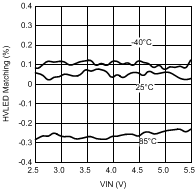
| ILED = 20 mA | ||
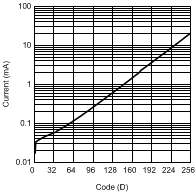
| VIN = 3.6 V | ||
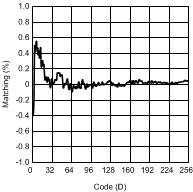
| VIN = 3.6 V | ||
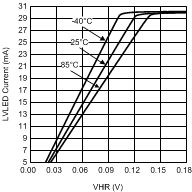
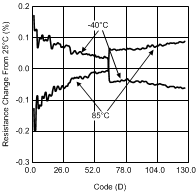
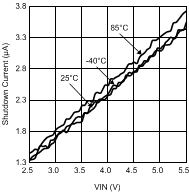
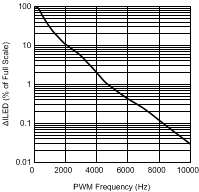
| 50% Duty Cycle | ILED Full_scale = 20.2 mA | |
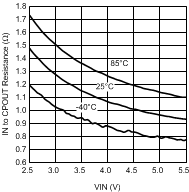
| 1x Gain | ||
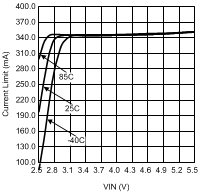
| 1× Gain | ||
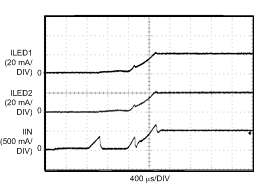
| VIN = 3.6 V | 20 mA/String | 2×8 LEDs |
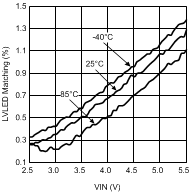
| ILED = 20 mA | ||
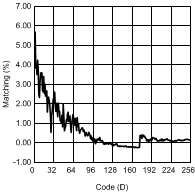
| VIN = 3.6 V | ||
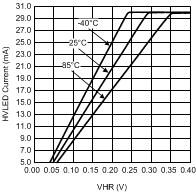
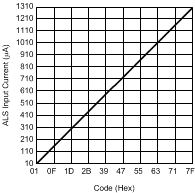
| VALS = 2 V | ||
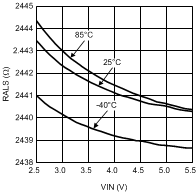
| (Code 0x50) | ||
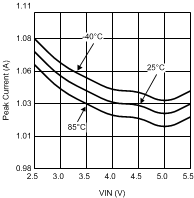
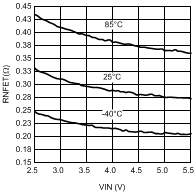
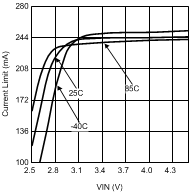
| 2× Gain | ||
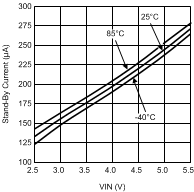
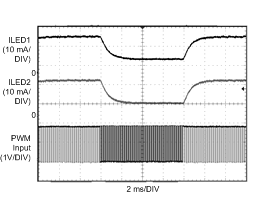
| D = 30% To 90% | ƒPWM = 10 kHz | |
| ILED_FULL SCALE = 20.2 mA | ||
